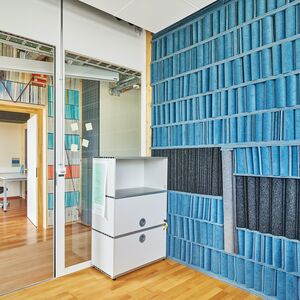Building with recycled materials
27.09.2021

The challenge of using mainly deconstructed materials and components was taken up in the construction of "Sprint". The offices are located at NEST, the research and innovation platform of Empa (the ETH Domain's interdisciplinary research institute for materials science and technology development) and Eawag (the Swiss Federal Institute of Aquatic Science and Technology).
Inaugurated at the end of August, this module gives new life to materials and components. This method has resulted in 12 individual offices that comply with the COVID-19 standard. The recovery of materials and components is intended to offer an alternative to building with new materials and to meet the market's criteria of speed and flexibility.
Building with reused materials is not easy. It requires a rethinking of the planning and conduct of a construction site. However, for this project, second-hand materials were found more quickly than new materials. Furthermore, the reuse of different materials leads to innovation, as it is necessary to be creative in order to reuse these materials. For example, partitions have been built out of salvaged bricks, old books or old carpets.
For this project, the reuse of materials was not cheaper than the conventional alternative. For the time being, the added value is mainly ecological. Moreover, not everything is second-hand. For example, it is better to use new pumps, valves and other technical components. It is possible to check the service life of these technical elements, but it is time-consuming and expensive. There is therefore a balance to be struck between what is feasible with recycled materials and what is not.
Inaugurated at the end of August, this module gives new life to materials and components. This method has resulted in 12 individual offices that comply with the COVID-19 standard. The recovery of materials and components is intended to offer an alternative to building with new materials and to meet the market's criteria of speed and flexibility.
Building with reused materials is not easy. It requires a rethinking of the planning and conduct of a construction site. However, for this project, second-hand materials were found more quickly than new materials. Furthermore, the reuse of different materials leads to innovation, as it is necessary to be creative in order to reuse these materials. For example, partitions have been built out of salvaged bricks, old books or old carpets.
For this project, the reuse of materials was not cheaper than the conventional alternative. For the time being, the added value is mainly ecological. Moreover, not everything is second-hand. For example, it is better to use new pumps, valves and other technical components. It is possible to check the service life of these technical elements, but it is time-consuming and expensive. There is therefore a balance to be struck between what is feasible with recycled materials and what is not.


